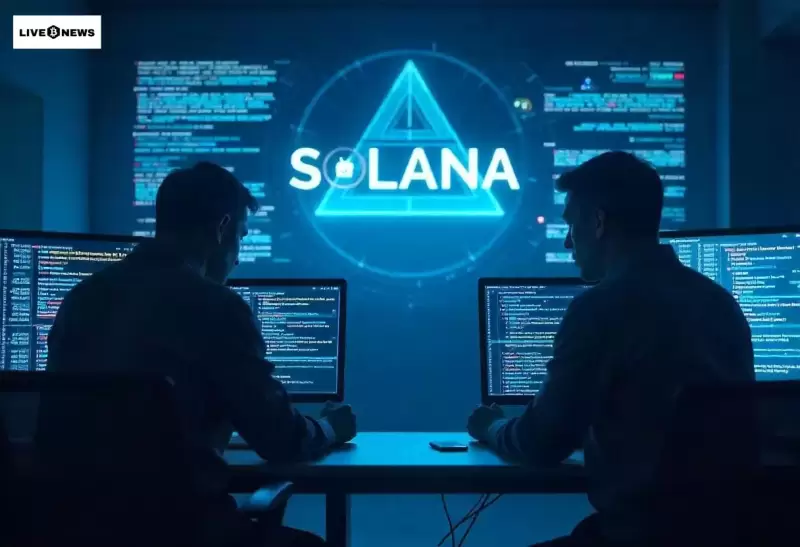 |
|
 |
|
 |
|
 |
|
 |
|
 |
|
 |
|
 |
|
 |
|
 |
|
 |
|
 |
|
 |
|
 |
|
 |
|
Cryptocurrency News Articles
A severe zero-day flaw in the confidential transfer of the Token-2022 standard was detected
May 06, 2025 at 11:06 am
The privacy-focused Token-2022 secret transfers, which use zero-knowledge proofs to preserve transaction secrecy, were allegedly linked to the issue

A severe zero-day flaw in the Token-2022 standard’s confidential transfer was detected by the Solana Foundation on April 16, 2025. The vulnerability enabled attackers to manipulate zero-knowledge proofs, which could lead to unauthorized token minting or theft of user assets.
While the issue was quickly resolved, with a fix being distributed within two days, the response has sparked a conversation about centralization in the Solana ecosystem.
As per reports, the issue was linked to privacy-focused Token-2022 secret transfers, which use zero-knowledge proofs to preserve transaction secrecy. The flaw, if exploited, could allow an actor to mint an unlimited supply of tokens or drain assets from user accounts. Fortunately, no funds were lost in the incident.
Key contributors, including Anza, Firedancer, Jito, Asymmetric Research, Neodyme, and OtterSec, worked in coordinated efforts to patch the vulnerability. By April 18, the majority of validators had adopted the updated version of the code, securing the network from possible exploits. The Solana Foundation detailed the effectiveness of this response in a detailed post-mortem published on May 2.
But the private handling of the issue has also come under fire. Some argue that this undermines transparency as the Foundation chose not to disclose the vulnerability publicly until the fix was implemented.
This approach has been criticized by some on platforms like X as it highlights centralization risks, given that a coordinated action of a handful of validators would raise questions about the decentralized nature of Solana.
Rapid Fix, Hidden Risks
The Solana Foundation also published a post-mortem detailing the timeline of the incident. The vulnerability was detected on April 16, and we started to develop the solution right away. The patch was rolled out within 48 hours, and the network was stable. The report also confirmed that no user funds were lost, and the feature that allows users to conduct confidential transfers was secured against potential abuse.
The resolution turned out successfully, but the lack of immediate public disclosure has stirred up the debate. And some stakeholders are concerned that users weren’t alerted to the risks before the fix went live, because the fix was rushed into place in a two-day window. They argue that this opacity could undermine the trust in Solana’s decentralization credentials as the platform is facing increasing regulatory scrutiny.
As per a 2023 audit by Halborn, the Token-2022 program had vulnerabilities that allowed users to bypass transfer fees or move non-transferable tokens. These conflicts were settled, but the recent case highlights the lasting struggles of keeping safety when working on a quick-paced blockchain world.
Also, the Foundation’s decision to put speed over transparency has been compared by some to the 2022 Terra–Luna collapse, which resulted in the loss of trust in centralized decision-making in blockchain networks. Solana’s situation may be different, but the incident illustrates that security and openness are two sides of the same coin.
Centralization Concerns Take Center Stage
Solana’s decentralized structure has raised questions after swift coordination among validators. In a May 5 post on X, Neoma Ventures expressed concern about the fact that a small group was able to make so many changes so quickly, which raised the question of whether the level of centralization behind that would run contrary to the principles of blockchain technology. It is also in line with broader debates within the crypto community about governance and control.
Solana’s reliance on a proof-of-stake model as outlined in its white paper has long been discussed. The model allows for high scalability and speed at the expense of concentrating influence on a smaller number of validators. The recent incident has resulted in increased pressure on transparency and better disclosure standards to regain trust from users.
Disclaimer:info@kdj.com
The information provided is not trading advice. kdj.com does not assume any responsibility for any investments made based on the information provided in this article. Cryptocurrencies are highly volatile and it is highly recommended that you invest with caution after thorough research!
If you believe that the content used on this website infringes your copyright, please contact us immediately (info@kdj.com) and we will delete it promptly.
-

-

-

-

-

-

-

-

- When Will Alt Season Arrive? Bitcoin's Dominance, Macroeconomic Headwinds, and Regulatory Uncertainty Delay the Surge of Altcoins
- May 06, 2025 at 04:40 pm
- For months, crypto traders have been anxiously refreshing price charts in anticipation of the arrival of “alt season,” when altcoins would surge. However, despite bullish predictions and brief rallies, alt season has yet to materialize.
-























































